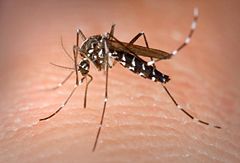Because tiger mosquitoes don't fly far from their breeding places, if you and your neighbors work at eliminating breeding sites in your yards, you will have relatively few mosquitoes.
(photo: Susan Ellis, Bugwood.org)The tiger mosquito
 The tiger mosquito (called "tiger" because of its
black-and-white stripes) is an accidental import from Japan. This species (Aedes
albopictus) was unknown in North America before 1985,
when it first
appeared in Texas, having arrived in a shipment of used tires. Since that
year it has spread
through the
Southeast, its spread helped by shipments of used tires.
The first
appearance of the tiger mosquito in this area was in 1987, near a tire
reprocessing plant in Baltimore. Washington is near the extreme end of this
range of distribution (lucky us). "Older residential areas with a good deal of
shade are preferred sites", reports the Maryland Department of Agriculture.
Mount Pleasant fits that description, and it's no wonder that we're plagued with
these mosquitoes.
The tiger mosquito (called "tiger" because of its
black-and-white stripes) is an accidental import from Japan. This species (Aedes
albopictus) was unknown in North America before 1985,
when it first
appeared in Texas, having arrived in a shipment of used tires. Since that
year it has spread
through the
Southeast, its spread helped by shipments of used tires.
The first
appearance of the tiger mosquito in this area was in 1987, near a tire
reprocessing plant in Baltimore. Washington is near the extreme end of this
range of distribution (lucky us). "Older residential areas with a good deal of
shade are preferred sites", reports the Maryland Department of Agriculture.
Mount Pleasant fits that description, and it's no wonder that we're plagued with
these mosquitoes.
These mosquitoes are especially annoying because they
feed all day long, not just at dawn and dusk. They prefer to feed close to the
ground, on your bare ankles and legs. They are quick and agile, and are
surpisingly good at evading slaps. And yes, they transmit diseases: West Nile
here, and an outbreak of
an
exotic Asian disease in Italy
, chikungunya,
has been blamed on the arrival of tiger mosquitoes in that country.
Controlling this pest
This is not a problem that is going to be solved by calling in some city
service to fix it. (Neighborhood-wide spraying is neither effective nor
advisable.) As is so often the case, it's up to us residents to solve the
problem, as best we can.
These mosquitoes do not fly far from their
breeding places -- 200 yards, it is said. Hence, if you can simply eliminate
breeding spots within that range of your back yard, you'll be nearly free of
this nuisance. Of course, in our neighborhoods 200 yards is a long distance, so
this has to engage the cooperation of your neighbors.
These mosquitoes
are "container" mosquitoes, breeding not in open pools of water, but on the
walls of small cup-like containers of water. The mosquito's eggs are deposited
on the dry walls of the container, not in the water. When rain causes the water
in the container to rise above the level of the eggs, the eggs hatch, releasing
larvae into the water. One to a few weeks later, the larvae mature, releasing
adult mosquitoes.
This odd life cycle (said to have developed in forests)
leads to the obvious means of controlling mosquito populations: eliminate all
such containers of water. Containers that cannot be removed must be emptied, at
least weekly, to dispose of any larvae.
The Maryland Department of
Agriculture offers this
list of "tips" for controlling tiger mosquito populations.
If we all work
hard at controlling these "container" breeding sites, we can reduce the
summertime plague of tiger mosquitoes.
Return to home
page created May 25, 2008
